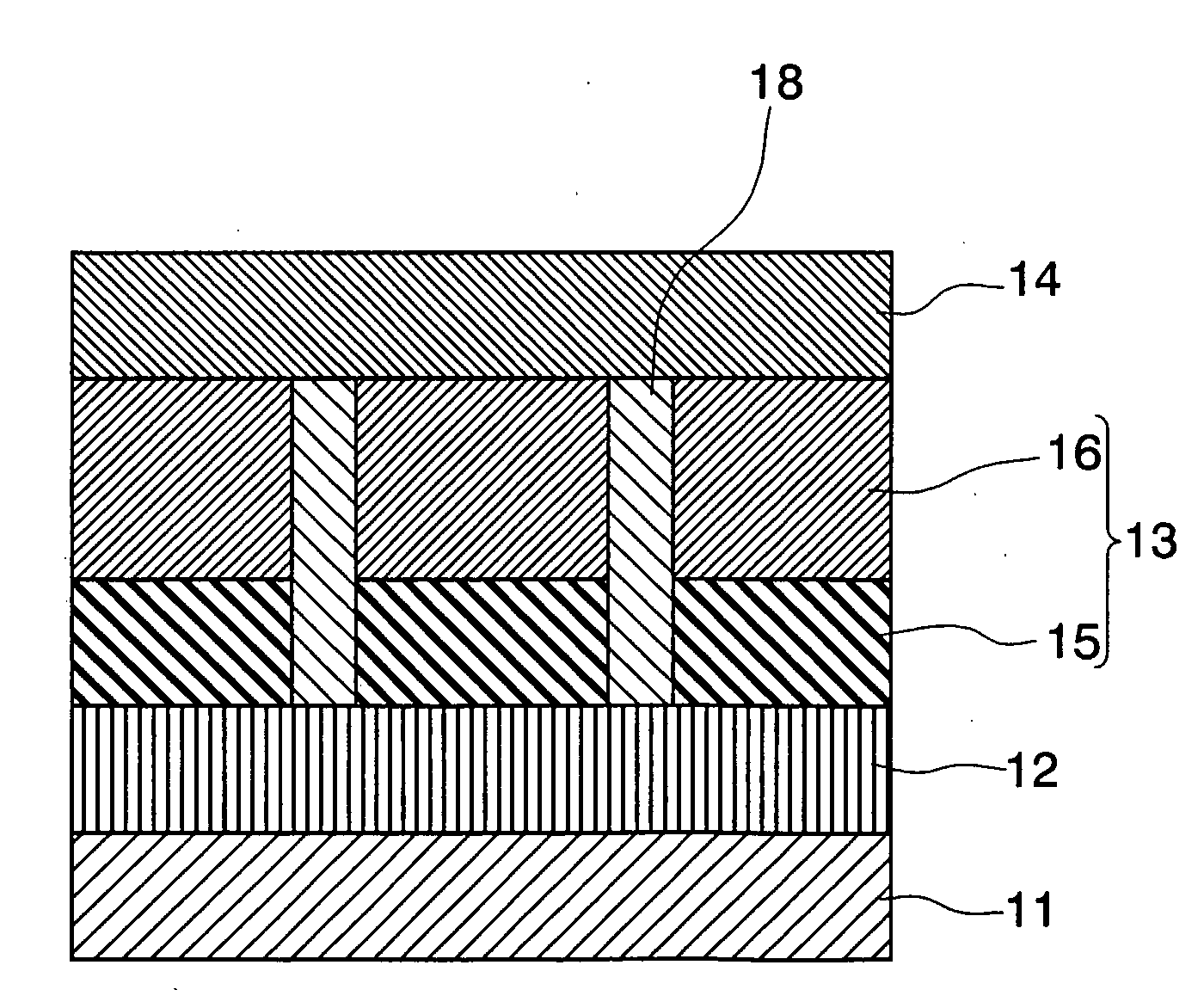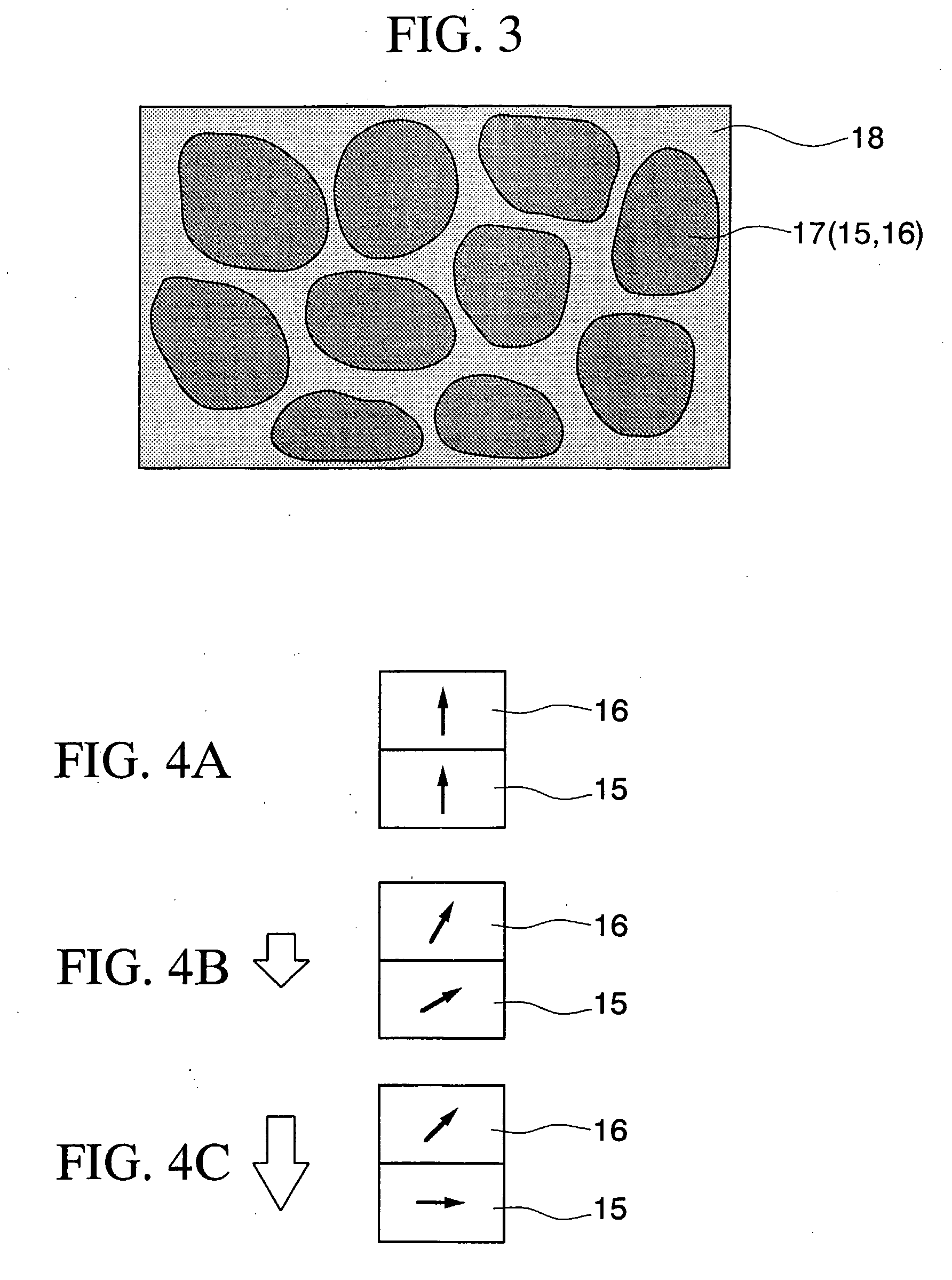Magnetic recording medium and magnetic recording and reproducing apparatus
a recording medium and magnetic recording technology, applied in the direction of instruments, magnetic bodies, ultrathin/granular films, etc., can solve the problem of difficult to obtain magnetically separated soft magnetic areas to achieve a tilted medium with reduced coercivity
- Summary
- Abstract
- Description
- Claims
- Application Information
AI Technical Summary
Benefits of technology
Problems solved by technology
Method used
Image
Examples
example 1
[0087]In Example 1, first an LLG simulation was carried to determine whether the above-described coercivity Hc lowering effect of the invention can occur within a practical range. The results of the simulation are shown in FIG. 10.
[0088]In this simulation, the magnetic anisotropy Ku of 6 Merg / cc and for the saturation magnetization of 500 emu / cc were chosen for the magnetic properties of the primary recording layer. These are values close to the properties of the CoCrPt used in the magnetic recording layer of perpendicular magnetic recording media. The magnetic anisotropy Ku of −4 Merg / cc and for the saturation magnetization Ms of 1,000 emu / cc were chosen for the magnetic properties of the secondary recording layer. These are values close to the properties of CoIr. The exchange coupling constant, both within the magnetic grains and between the primary recording layer and the secondary recording layer, was set at 0.5 μerg / cm. The mesh size of the simulation was set at 1 cubic nanomet...
example 2
[0098]In Example 2, magnetic disks for the 2.5 inch hard disk drive described below were fabricated based on the results of Example 1. First, a nonmagnetic glass substrate (TS-10SX, made by Ohara Inc.) was introduced into the vacuum chamber of a sputtering system (model C-3010, made by Canon ANELVA Corporation), following which the following layers were successively formed on the substrate under a vacuum of 1×10−6 Pa: a soft magnetic under layer made of CoZrNb to a thickness of 100 nm, a seed layer of tantalum to a thickness of 5 nm, an under layer of platinum to a thickness of 10 nm, an under layer of ruthenium to a thickness of 10 nm, a primary recording layer of CoCrPt and SiO2 to a thickness of t1=18 nm, 17 nm, 15 nm, 9 nm, or 3 nm, a secondary recording layer of Co80Ir20 to a thickness of (18−t1)=0 nm, 1 nm, 3 nm, 9 nm, or 15 nm and a protective layer of carbon to a thickness of 4 nm. Next, the substrate on which these successive layers had been formed was removed from the vacu...
example 3
[0105]A magnetic recording medium similar to that in Example 2 was produced, except that the samples were prepared in which the thickness t1 of the primary recording layer was set at 9 nm, and the material making up the secondary recording layer was CoFe, MnSb, FeC or Fe3Pt. All of these samples had a coercivity Hc of 3 to 4 kOe, indicating that a coercivity Hc reducing effect was obtained.
PUM
| Property | Measurement | Unit |
|---|---|---|
| thickness | aaaaa | aaaaa |
| size | aaaaa | aaaaa |
| size | aaaaa | aaaaa |
Abstract
Description
Claims
Application Information
 Login to View More
Login to View More - R&D
- Intellectual Property
- Life Sciences
- Materials
- Tech Scout
- Unparalleled Data Quality
- Higher Quality Content
- 60% Fewer Hallucinations
Browse by: Latest US Patents, China's latest patents, Technical Efficacy Thesaurus, Application Domain, Technology Topic, Popular Technical Reports.
© 2025 PatSnap. All rights reserved.Legal|Privacy policy|Modern Slavery Act Transparency Statement|Sitemap|About US| Contact US: help@patsnap.com



